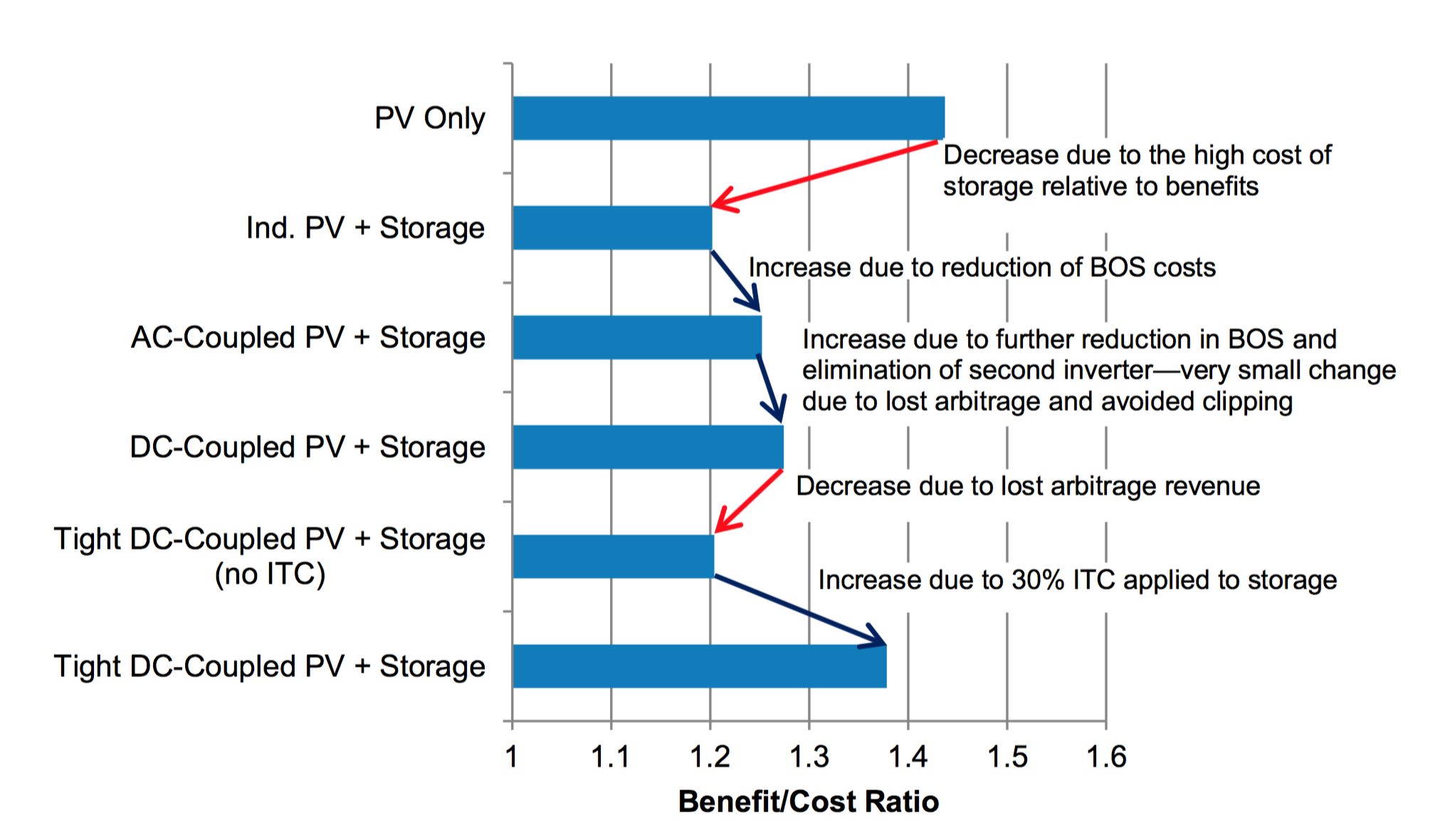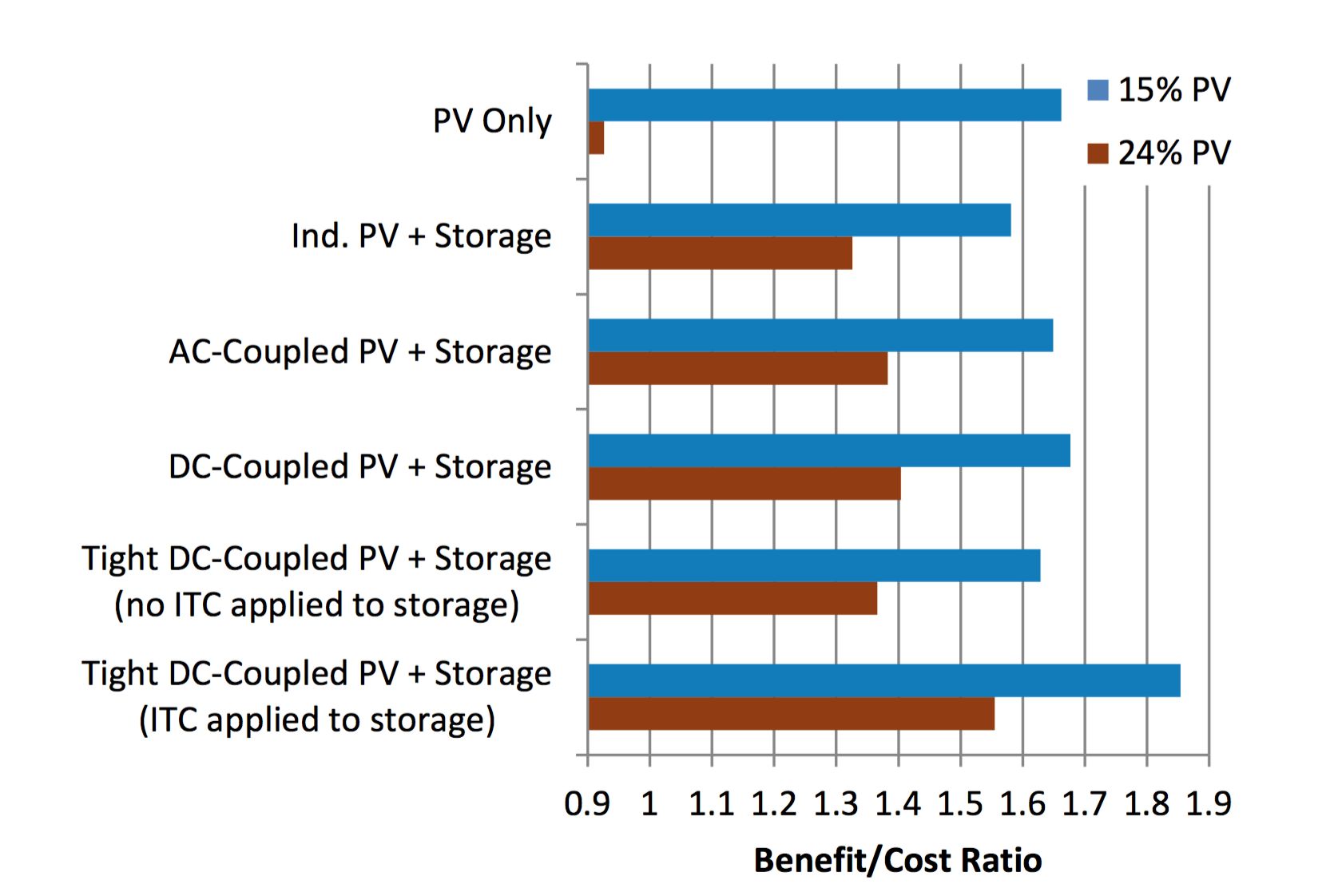With so few utility-scale solar-plus-storage projects actually built, we don’t have much data on how their economics work.
Now those companies considering it -- a group that includes all major solar developers -- have a bit more insight, thanks to Paul Denholm and his colleagues at the National Renewable Energy Laboratory.
Their new analysis models the benefit-cost ratio of several solar and storage configurations under present circumstances and projected cases in 2020.
In today’s market, under the assumptions of the model, standalone PV beats any of the hybrid combinations. Fast-forward to 2020 with an assumed 15 percent solar penetration, and DC-coupled PV-plus-storage with the federal Investment Tax Credit takes the lead.
In a 2020 scenario with 24 percent solar penetration, standalone PV plummets in value and all types of solar-plus-storage take the lead.
The real-world economics will change from place to place, but the trend here is clear: As the share of variable solar generation increases, so will the payoff for siting storage in the same place.
That evidence suggests the data is catching up to the aspirations of the storage industry, which Denholm has been tracking for the last 15 years.
“The hype might actually be real,” he said. “If these somewhat conservative projections do come true, then yes, by 2020 solar-plus-storage will be a cost-competitive source of dispatchable energy.”
Not just cost
It’s easy enough to calculate levelized cost of energy for a solar-plus-storage system, and it will always be more expensive than standalone solar. But that metric fails to capture the additional value that can be gained by adding storage.
If the developer needs to deliver power for the evening peak, a storage-assisted PV plant will be significantly more valuable than the alternative.
The authors instead use a benefit-to-cost ratio found by dividing the annualized energy revenue and capacity value of the system by its annualized capital and operating expenses.
The system modeled is located in Southern California and wields 50 megawatts-AC of PV capacity with 30 megawatts of 4-hour duration storage.
The researchers focused specifically on this asset’s value for energy and capacity, essentially pitting it against a gas peaker plant. They excluded other uses for storage, like ancillary services or transmission and distribution deferral, meaning the storage can likely deliver even more value than what was modeled here.
Market distortion
Here’s what the results look like for today’s grid:

Benefit/cost outcomes for PV+storage using 2014 electricity prices and 2016 estimated PV and battery costs. (Image credit: NREL)
The Investment Tax Credit is working some mischief here.
Notice that without the ITC, the “tightly coupled” DC system, which only charges the batteries from the PV array, ranks among the worst paybacks. That configuration sacrifices revenue from arbitraging cheap grid power.
When you add the 30 percent ITC, which is available to storage that only charges from renewable sources, the tight DC system jumps to second best, after standalone PV.
That’s evidence of market distortion at work. Congress has not passed a standalone ITC for storage. The policy on the books drives developers toward charging their storage from solar alone, even when it might make more sense to charge from cheap grid power at night, for instance.
“You’re probably not incentivizing the optimal way of using that resource for the ultimate benefit,” Denholm said.
That raises the chances of stranded assets. What if the industry chases the ITC, only to be stuck with a bunch of arbitrarily limited storage systems when the ITC runs out?
That’s not a concern, Denholm said, because in most cases, it is possible to unlock grid charging with some tweaks to the storage hardware and software.
The future is hybrid
Standalone PV wins out in the current market context (as modeled; there are certainly cases where it already triumphs), which features 6 percent solar penetration. The future holds a different outcome.
There’s a well-established body of literature on the declining marginal value of additional solar power. As the amount of solar generation hitting the grid increases, so does the value of storing that power for use in the evening peak.

The 2020 case with a 30 percent investment tax credit. (Image credit: NREL)
Projecting storage and solar costs in 2020 with 15 percent solar penetration, the authors find standalone solar losing its edge. The nonexclusive DC-coupled solar-plus-storage beats it, and the tight DC-coupled system with the ITC takes first place, with its benefits almost doubling its costs.
At 24 percent solar penetration, standalone PV’s benefit-to-cost ratio sinks below 1, meaning that costs outweigh benefits. In that scenario, any combination of solar and storage beats the standalone solar.
In the same 2020 scenarios run without any ITC, all forms of solar-plus-storage beat standalone solar at 15 and 24 percent penetration.
In those cases, the unrestricted DC-coupled system has the best value proposition, but it’s very close to the tightly coupled system. That’s because in that grid, much of the power charging the storage will be from solar; the value of flexible charging is not as pronounced as it is today.
The study fits into the broader body of work documenting how storage can make itself useful as the grid approaches higher renewable energy penetrations. It also jibes with the market conditions we’ve seen so far: A lot of people are talking about pairing these two resources, but few have done it outside of the island grid context. Large-scale projects going through bidding right now would come on-line around 2020.
In that light, there’s a case to be made for building the hybrid systems before the ITC runs out, knowing that the operational value is only going to grow as solar penetration rises. Once that tax credit is gobbled up, the system can always be changed to operate more flexibly (some might say sensibly) down the road.
Join GTM for a deep dive into the budding domestic energy storage market at the U.S. Energy Storage Summit 2017. Utilities, financiers, regulators, technology innovators, and storage practitioners will all come together for two full days of data-intensive presentations, analyst-led panel sessions with industry leaders, and extensive, high-level networking. Learn more here.



